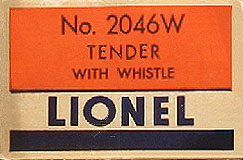2. Those engines built in 1950 and 1951 have large rubber-stamped number on the cab. All other issues, with the exception of some late post war period releases, would have smaller heat stamped numbers.

3. The trailing truck of this locomotive changed in 1954. Prior to this date, this truck was of die-cast metal construction, but those engines produced after 1954 would have sheet metal trucks with plastic side frames.

4. In 1957, Lionel changed the center rail pick-up assembly to a shorter, smaller roller assembly that was held in place by one screw.

5. Flagstaffs appear on the pilot in early issues. The earliest issued had hexagonal bases, while later issues had round bases and were sometimes painted BLACK. These extra detail parts would be eliminated after 1956.

These are the major differences that define the five variations:

Variation A: SILVER rubber-stamped cab numbers, three cab windows, flagstaffs and a die-cast trailing truck (1950-1951).

Variation B: WHITE heat-stamped cab numbers, four cab windows, flagstaffs and a die-cast trailing truck (1953-1954).

Variation C: identical to Variation B except with a sheet metal trailing truck. (1955-1956).

Variation D: WHITE heat-stamped numbers, no flagstaffs, and revised center rail electrical pick-up assembly (1957-1968).

Variation E: same as Variation D except WHITE rubber-stamped cab numbers.

This locomotive was issued with three different tenders that were used over the time of production: 2671WX, 2046W, or 736W. All of the Berkshires that Lionel produced were designed to run on the standard O Gauge tubular track of the post war years and will not operate properly on the tighter curves of O27 Gauge track.
 |
|





 |





